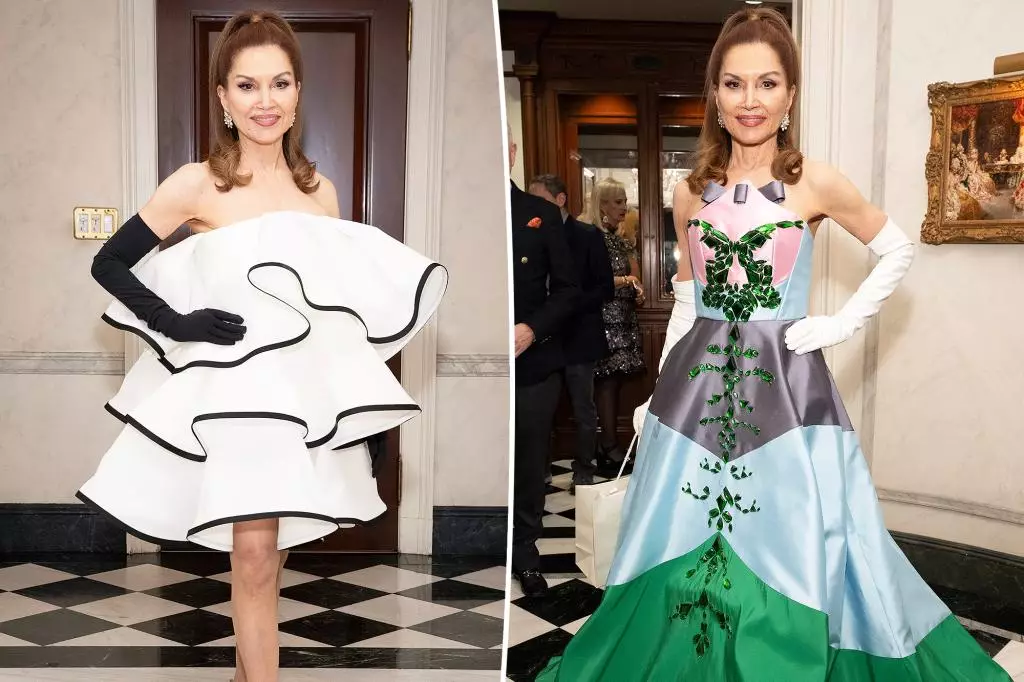In the world of high society, age often becomes both a point of pride and a subject of intrigue. Jean Shafiroff, a noted socialite and philanthropist, exemplifies this duality. Recently, she celebrated a birthday that she resolutely chose to keep shrouded in mystery, joking with guests about her decision to withhold her age as a ‘security question.’ This playful deflection invites a broader conversation about ageism, personal agency, and societal expectations regarding aging, particularly for women in the public eye.
At her glitzy cocktail celebration held at her upscale Park Avenue apartment, the atmosphere buzzed with excitement as guests speculated on Shafiroff’s age. One attendee gushed about how “amazing” she looked at 60, while another, perhaps more cautious, guessed 71, only to backtrack and acknowledge the ease of finding her age online. This blend of admiration and trepidation illustrates the complex relationship society has with women celebrating milestones; while beauty can seemingly transcend time, disclosing one’s age remains a sensitive topic.
Shafiroff’s strategy of claiming to be “perpetually 49,” instead of focusing on numerics, showcases her contoured approach to aging. It highlights an empowering message about redefining beauty standards and pushing against cultural clichés that often bind women to conventional narratives about aging.
Beyond the playful banter surrounding her age, Shafiroff also captivated attendees with her striking fashion choices throughout the evening—undoubtedly a testament to the concept that when you look good, you feel good. Not one, not two, but four fabulous outfit changes donned the birthday girl during her two-hour soirée. This frenzy of sartorial splendor was no coincidence; taking place during New York’s pivotal fashion week, the event was a vibrant celebration of style, creativity, and personal expression.
Among the highlights of her wardrobe was a stunning white gown designed by Wes Gordon, aptly named the “birthday cake dress.” This whimsical choice came after she attended Gordon’s fashion show for Carolina Herrera earlier that day, encapsulating not just her personal flair, but also the synergy between fashion and celebration that defines high-society occasions.
Moreover, she ensured her evening sparkle extended beyond her own attire. With contributions from esteemed designers such as Victor de Souza and Malan Breton, Shafiroff’s wardrobe became a narrative canvas, blending artistry with the festive spirit. Here, fashion transcends mere aesthetics—it serves as a form of communication and a lens through which social connections are fostered.
Yet, amid the glitz and glamour, Shafiroff’s celebration was also grounded in an impactful mission. In lieu of accepting gifts—a common practice among the elite—she encouraged her guests to donate to the American Red Cross to support victims of the California fires. This thoughtful initiative underscores a significant aspect of her identity: a commitment to philanthropy that aligns more with substantive impact than superficial celebration.
In her reflections on the devastation caused by the fires, she expressed empathy for those affected, pointing out that many of the victims were left without insurance and had lost everything they owned. “I hate fire,” she shared, illustrating a genuine concern rooted in humanity. This admission reflects a poignant duality—while the event was undoubtedly a celebration, it also served as a reminder of the harsh realities faced by many.
Shafiroff’s acknowledgement that such disasters could happen to anyone echoes an essential truth about society; privilege does not insulate us from vulnerability. Her desire to prompt real action, rather than mere conversation, comprises a moral imperative that resonates deeply within the fabric of communal responsibility.
The guest list of Shafiroff’s celebration read like a who’s who of social and cultural influencers, featuring names such as Julia Haart, Ruth Miller, and the famed Candace Bushnell. Their presence not only signifies solidarity within the social elite but also furthers the notion that gatherings of this nature can and should blend indulgence with purpose.
Jean Shafiroff’s birthday celebration stood as a beautiful interplay between joyful festivity and earnest charitable endeavors. The evening encapsulated an essential narrative about the importance of women redefining their own stories as they age, the transformative potential of fashion, and the social responsibilities that accompany privilege. It reminds us that while we may toast to another year, there lies a greater story woven into the fabric of our celebrations—a tale of resilience, empathy, and communal engagement.

